2.93GHz with DDR2-1067 Performance Comparison
It is clear enough that despite the poorer memory bandwidth, Core 2 Duo is the performance leader by a substantial margin at stock speeds. You have seen that in all of the results posted in this article. This conclusion will not satisfy all our readers, however. Many have theorized every incarnation of performance imaginable with AM2 having higher clock speed, higher bandwidth, or higher speed memory than it currently does.
To best answer these questions we put together the fairest comparison we could think of to directly compare Core 2 Duo and AMD AM2. This consists of running both processors at the exact same speed - 2.93GHz - achieved at the same ratios - 11x266. This involves overclocking the AM2 FX62 to 2.93GHz and raising the "bus" speed to 266. That allows an 11x266 ratio to match Core 2 Duo. The desirable side effect is that while AM2 does not really support DDR2-1067, by setting the memory to DDR2-800 we reach DDR2-1067 speed at the 266 speed setting. While this slightly stacks the deck in AMD's favor, it is as close as it is possible to get at running the two systems at the same speed, same memory timings, same memory voltages, same memory, and same video card. We are comparing two identically configured systems with AM2 powering one system and Core 2 Duo powering the other system.
Results are particularly interesting in that the fastest current AM2 processor, the FX62, is overclocked about 5% in CPU speed and 33% in "bus" speed over a stock AM2 system.
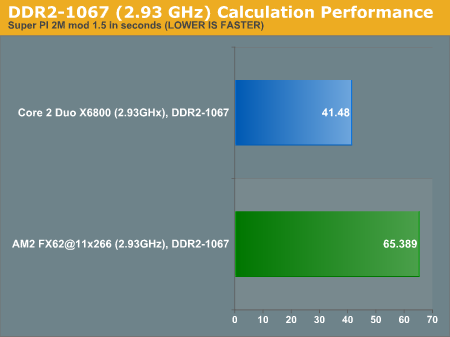
Frankly the gap that remains in Super Pi results when comparing AM2 and Core 2 Duo at the same speed was something of a shock. Clock for clock, with all other variables the same, Core 2 Duo is still almost 60% faster than AM2. There is nothing complex about calculating the value of Pi to 2 million places, but it does show the true power of Conroe in computation-intensive tasks.
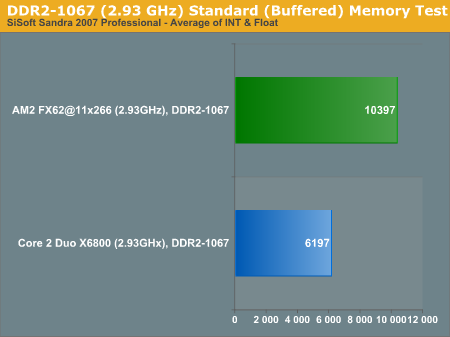
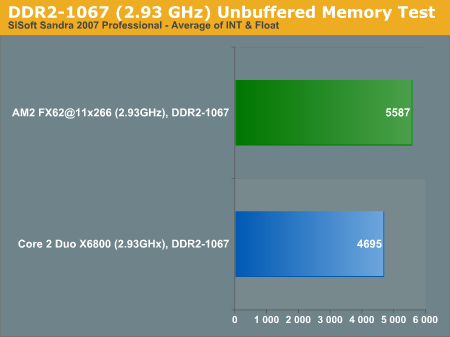
Despite the improvements Intel has made in intelligent read-ahead for memory, AM2 still has a huge lead in buffered memory bandwidth. This is a result of the superior on-processor memory controller used on AM2. The results become much closer in Unbuffered memory results, which is normally more revealing of performance in real-world applications, but AM2 still has a wider memory bandwidth. The unfortunate reality is AM2 is not starved for memory bandwidth and cannot really make effective use of this advantage. AMD clearly knows how to deliver memory bandwidth, so the task now becomes to modify their core logic to make better use of this advantage.
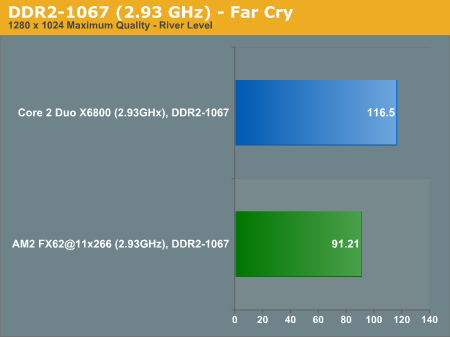
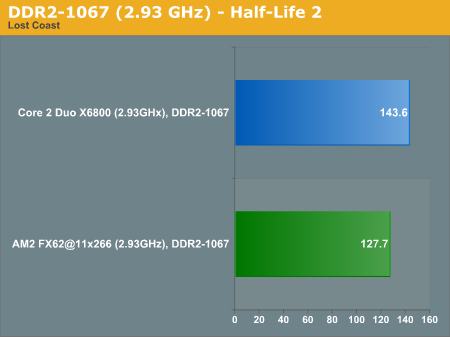
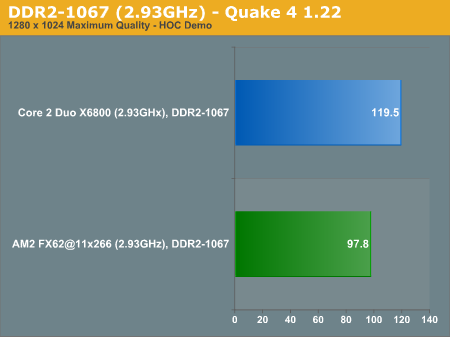
We can now say with authority that Core 2 Duo is the faster performer clock-for-clock across the board. At the same 2.93GHz Far Cry is 27.7% faster, Half-Life 2: Lost Coast is 12.4% faster, and Quake 4 is 22.2% faster on Core 2 Duo. Of course AMD does not currently have a 2.93GHz CPU, so we tested by overclocking FX62. This suggests that FX64, or whatever it will be called, will not help much at 3.0GHz with a 200 clock speed.
It is clear enough that despite the poorer memory bandwidth, Core 2 Duo is the performance leader by a substantial margin at stock speeds. You have seen that in all of the results posted in this article. This conclusion will not satisfy all our readers, however. Many have theorized every incarnation of performance imaginable with AM2 having higher clock speed, higher bandwidth, or higher speed memory than it currently does.
To best answer these questions we put together the fairest comparison we could think of to directly compare Core 2 Duo and AMD AM2. This consists of running both processors at the exact same speed - 2.93GHz - achieved at the same ratios - 11x266. This involves overclocking the AM2 FX62 to 2.93GHz and raising the "bus" speed to 266. That allows an 11x266 ratio to match Core 2 Duo. The desirable side effect is that while AM2 does not really support DDR2-1067, by setting the memory to DDR2-800 we reach DDR2-1067 speed at the 266 speed setting. While this slightly stacks the deck in AMD's favor, it is as close as it is possible to get at running the two systems at the same speed, same memory timings, same memory voltages, same memory, and same video card. We are comparing two identically configured systems with AM2 powering one system and Core 2 Duo powering the other system.
Results are particularly interesting in that the fastest current AM2 processor, the FX62, is overclocked about 5% in CPU speed and 33% in "bus" speed over a stock AM2 system.

Frankly the gap that remains in Super Pi results when comparing AM2 and Core 2 Duo at the same speed was something of a shock. Clock for clock, with all other variables the same, Core 2 Duo is still almost 60% faster than AM2. There is nothing complex about calculating the value of Pi to 2 million places, but it does show the true power of Conroe in computation-intensive tasks.


Despite the improvements Intel has made in intelligent read-ahead for memory, AM2 still has a huge lead in buffered memory bandwidth. This is a result of the superior on-processor memory controller used on AM2. The results become much closer in Unbuffered memory results, which is normally more revealing of performance in real-world applications, but AM2 still has a wider memory bandwidth. The unfortunate reality is AM2 is not starved for memory bandwidth and cannot really make effective use of this advantage. AMD clearly knows how to deliver memory bandwidth, so the task now becomes to modify their core logic to make better use of this advantage.



We can now say with authority that Core 2 Duo is the faster performer clock-for-clock across the board. At the same 2.93GHz Far Cry is 27.7% faster, Half-Life 2: Lost Coast is 12.4% faster, and Quake 4 is 22.2% faster on Core 2 Duo. Of course AMD does not currently have a 2.93GHz CPU, so we tested by overclocking FX62. This suggests that FX64, or whatever it will be called, will not help much at 3.0GHz with a 200 clock speed.










118 Comments
View All Comments
Calin - Tuesday, July 25, 2006 - link
I hate to rain on your parade, but the E6x00 and X6800 (Extreme) desktop CPU won't see a dual socket mainboard - for that you must use Xeons.As for multisocket, it was a niche market when multicore was not available, it is (maybe even more so) when multicore is available. Quad core will reduce it even more for desktop use. As for Intel knowing multicore is the future, I think their quad core will be on market before AMD's quad core - and if you are worrying about performance, keep worrying - we can small talk about this and that all day long.
AMD is in a much weaker position now - they must sell processors at half (or less) the profit they sold them until now, and the future is grim if you regard their profits. They could survive a long way, but they again are the budget CPUs, the best choice for small money.
As for 64-bit, you are certainly right - just that right now, 64-bit is of little use on desktop, the operating systems suffer from drivers problems, 64-bit applications are few and far between. You might need 64-bit and profit from it, but you are a minority now.
Ingas - Tuesday, July 25, 2006 - link
Maybe AMD in trouble.But not because of Core 2 Duo, but because of Woodcrest.
AMD alwais said that only server processors giving profit.
So ...
With Dell's AMD Now - maybe it's not trouble for AMD at all.
Calin - Wednesday, July 26, 2006 - link
Dell will only build enough AMD gear as not to lose business with their customers that WANT AMD gear. Even with higher performance losses on 4 sockets, Xeons Core2Duo (which are faster to boot) might put a fair fight against AMD - and then customers will choose based on other things than performance.I agree AMD Opteron scale better - but they start scaling from a lower performance
duploxxx - Wednesday, July 26, 2006 - link
do you really think you're sure about that. compare the same speed of opteron vs woodcrest and you will talk different.. i know how it performs because i have a wood es system on my table. and i am not a big fan of hexus reviews but look at the site, the wood isn't so bright and shining knowing again it is a compare of 3.0 vs 2.6.mesyn191 - Tuesday, July 25, 2006 - link
For 2S systems Intel will have the lead til' K8L becomes available, but for 4S AMD will have Intel beat and that lead will only increase when K8L becomes available. They're definitly gonna be hurting profit wise, but they'll be doing better than they were when it was P4C vs. AXP and they got through that so I see no reason to worry about them going into bankruptcy before K8L comes out in volume.sld - Tuesday, July 25, 2006 - link
What is wrong with a desktop user looking at the performance of a desktop cpu?When you can get a 4x4 at the same price/performance ratio curve as a Core 2 Duo, do please inform me.
I still believe AMD vs Intel is a David vs Goliath, although like the real David, AMD is beginning to get complacent with just a taste of power, and Core 2 is just what it needs to wake up and start dropping prices. :)
sld - Tuesday, July 25, 2006 - link
I forgot to mention that Core 2 is worth a consideration over the K8, but if we really want to punish Intel for being the monster they are, we should institute a complete boycott over the purchase of their existing Netburst inventory. That should hurt them quite a bit...Picture a scenario where new chips go straight out of the warehouse and into the embracing arm of a bulldozer. When it comes to that point do you think they will resort to giving the cpus away?
mattsaccount - Tuesday, July 25, 2006 - link
Are the Super Pi scores on page 7 right? The text says Conroe wins everything, but the Super Pi bench is reversed (I'm guessing the colors are just backward)Wesley Fink - Tuesday, July 25, 2006 - link
Since the lower score is better on Super Pi (faster time) the scales are reversed - from zero at the top to 90 at the bottom. The colors and values are correct, just upside down so the lowest score (fastest) is on the top like the other charts. You apparently caught that while I was typing this explanation :)highlandsun - Tuesday, July 25, 2006 - link
Have you got 32M digit results for Super Pi? Curious to see if that will exceed Conroe's cache and therefore reflect the real memory bandwidth. Also, results for running two copies of Super Pi at once on each system.